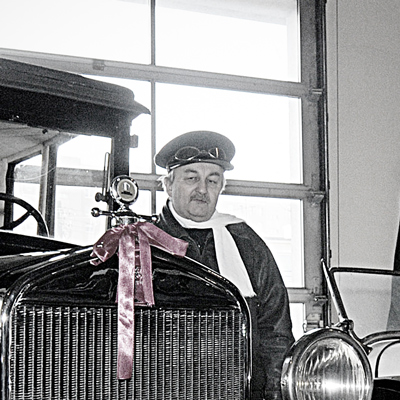About the Museum
In a small space, the Gdynia Motor Museum holds a wealth of history and the authentic automotive spirit of the 20th century. This impressive collection of vintage cars and motorcycles includes such gems as:
- Ford T – the first mass-produced passenger car,
- Buick Master Six – with all-authentic parts, down to the air in its tyres,
- Buick Deluxe – whose armoured version was used by Al Capone himself.
Apart from cars and motorcycles, the Gdynia Motor Museum boasts a rich collection of archival documents such as engine diagrams, photographs from the most famous rallies, and old road maps, which can be viewed on the mezzanine, in a tastefully decorated vintage café. Make sure to note the design of the exhibition hall: a cobbled street from the 1920s complete with the facades of tenement houses. All the doors, windows, signs and decorations are genuine parts of interwar buildings from Gdynia and Gdańsk, and the historic colours of the facades have been meticulously recreated.
Why Gdynia?
There are few places in Poland as well suited to presenting automotive history as Gdynia. At the turn of the 1920s, as black Ford Ts were rolling in large numbers off the conveyor belt in Detroit, the small village on the Baltic Sea was filling up with adventurous newcomers seeking a better life. In no time, the fishing village turned into Poland's window on the world, a large port city with modernist architecture and wide thoroughfares with modern limousines, buses and ubiquitous taxis driving up and down. It was on Gdynia's wharves that transports of new cars from around the world were unloaded before they were sent further into Poland.
Gdynia's first petrol station was launched as early as 1926. Car showrooms – Mercedes, Fiat and Chevrolet – popped up like mushrooms after the rain. Gdynia was the seat of the Ford representative office in Poland. Before the war the city had a hundred registered taxis and more cars per 10,000 residents than Warsaw. By the 1930s Kościuszki Square had become the scene of car rallies, whose tradition was later resurrected in the PRL period. In 1957, qualifying races for the Polish Automobile Championship attracted over 40,000 spectators. It is therefore no wonder that Gdynia, with such a rich tradition, is the perfect place for the Motor Museum.
Founder of the Gdynia Motor Museum

For most people, the car is just a means of transportation. But there are some who see it as a work of art. One of them is Witek Ciążkowski, creator of the Gdynia Motor Museum. To him, the smell of car grease is like luxury French perfume. His passion for cars and motorcycles dates back to his early childhood, and has since turned into boundless, unconditional love. "I could never draw anything besides a motorcycle or a car; whenever I tried, the drawing ended up being either one or the other", he recalls.
For most people, the car is just a means of transportation. But there are some who see it as a work of art. One of them is Witek Ciążkowski, creator of the Gdynia Motor Museum. To him, the smell of car grease is like luxury French perfume. His passion for cars and motorcycles dates back to his early childhood, and has since turned into boundless, unconditional love. "I could never draw anything besides a motorcycle or a car; whenever I tried, the drawing ended up being either one or the other", he recalls.
As the years went by, the collection grew too large for an ordinary garage, and Witek, by then a graduate of automotive technical school, started dreaming of establishing a museum. It was by no means an easy task. "For twenty-five years I applied to various authorities. Everyone promised help, but they never kept their word. In the end I said: 'Enough! I'll have to do it on my own!' With the help of a friend, I bought an old hall from the Port of Gdynia, just to tear it down and take the steel construction elements I needed. It took a long time to obtain all kinds of necessary permits and agreements, but eventually the hall was erected in its present location", recalls Witek, who was never one to choose an easy road, which has usually served him well.
It is thanks to this principle that all the exhibits in the Museum are fitted with genuine parts. Witek makes no compromises in this respect. Instead of using replacements, he prefers to wait or look into alternative sources, even on the other side of the globe... the satisfaction is all the greater when he is able to restore yet another classic vehicle to working order, and the greater the value of his unique collection. The Gdynia Motor Museum is the child of Witek's passion. It is the embodiment of his life's greatest dream, but also a way to fulfil a patriotic duty. As Witek says, "nobody respects a nation that does not respect its own history".


